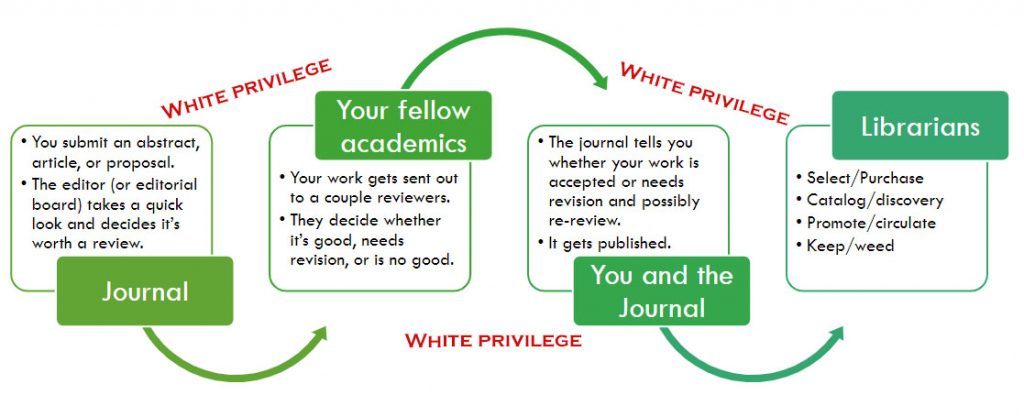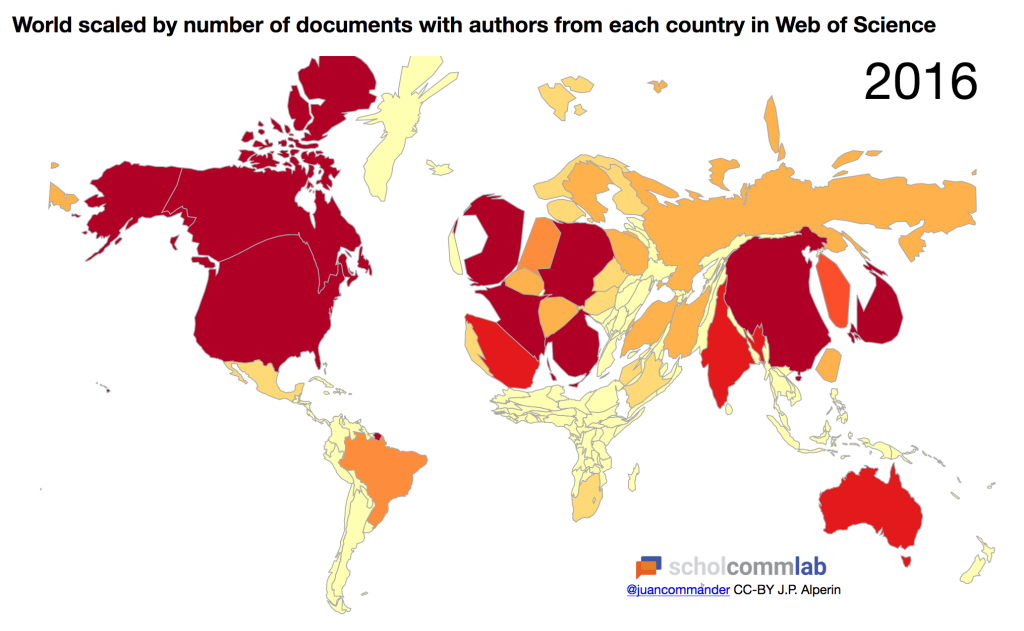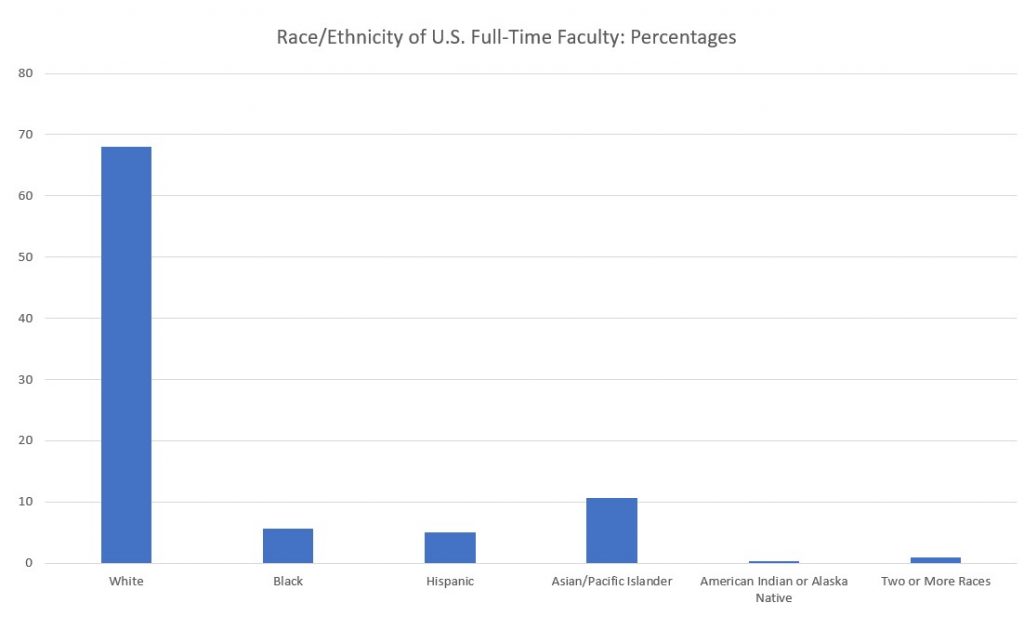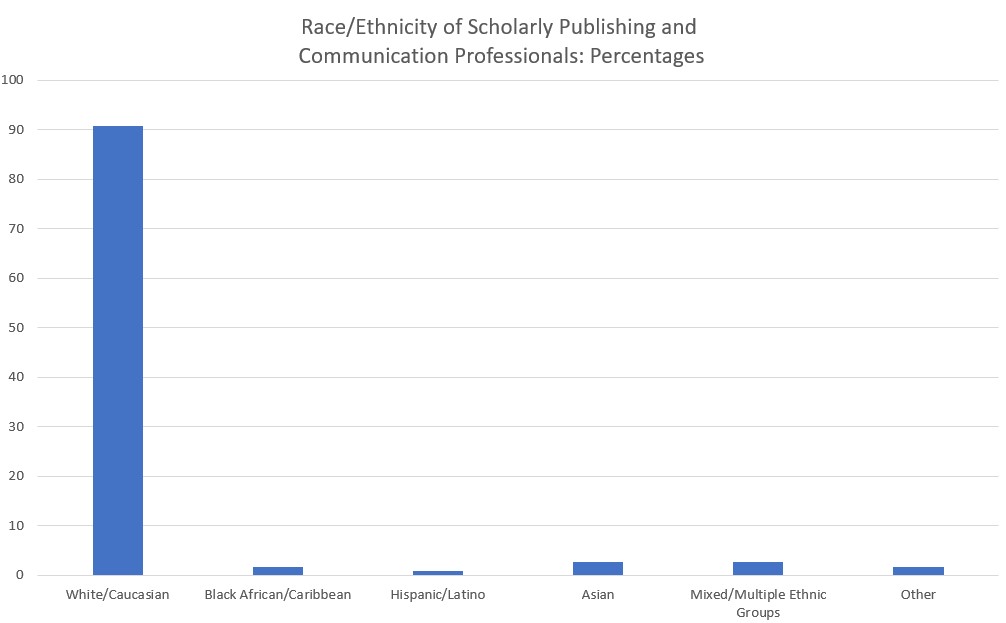Learning Objectives
- Examine whose voices are privileged and whose are excluded within the scholarly publishing system.
- Articulate why privilege within scholarly publishing is detrimental to the creation of new knowledge.
- Identify initiatives and developments designed to rectify inequities.
In addition to power and profit problematics within the scholarly publishing system, there is yet another inequitable dynamic at play: that of privilege. The system, both historically and at present, privileges certain participants while excluding others, leading to a lack of diversity and a culture of homogeneity that discourages innovation. We can see this at play both within academia and the publishing industry. In this chapter, we will examine privilege within scholarly communications as it pertains to race and ethnicity, gender, and global inequities.
I. Race and Ethnicity Inequities
Because academia is “so white,” as the article above points out, the research and scholarship produced by faculty authors within the academy is inherently biased. Authors do not conduct their scholarship in a vacuum; whether consciously or not, they are influenced by their background, including their race. If the majority of faculty authors (and, by extension, peer reviewers) are white — which data shows that they are — there will be a lack of diversity in the content, methods, and perspectives of the scholarship that they publish.
So . . . just how “white” is academia?
According to the most recent statistics from the U.S. Department of Education’s National Center for Education Statistics, 68% of full-time U.S. faculty are white, while only 5.6% are Black, 5.1% are Hispanic, 10.6% are Asian/Pacific Islander, and 0.4% are American Indian or Alaska Native. If we chart this data, it looks like this:
If we compare this data to the U.S. population as a whole, as well as to the U.S. undergraduate population, both of which have a 13% Black demographic, we see that the number of Black faculty is less than half what it should be to accurately reflect and represent the general U.S. and undergraduate populations.[2]
There are a number of ways in racism manifests itself in academia. Besides being underrepresented, faculty of color may experience marginalization, tokenism, microaggressions, and an inhospitable academic culture that discourages them from both entering the system and staying in it. Further, in what has been termed “epistemic exclusion,” the scholarship produced by faculty of color has been shown to be overlooked or devalued by formal evaluation systems such as tenure and promotion, and the faculty themselves made to feel invisible or illegitimate as scholars.[3] For example, if achieving tenure requires publication in “top-tier,” mainstream journals, but those same journals “tend not to publish work on topics that faculty of color are more likely to engage in (Diaz & Bergman,
2013), and specialized journals are deemed less respectable, then an evaluation system that privileges only a few publication outlets results in epistemic exclusion of certain types of scholarship and scholars” (Settles et al., 2021, p. 499).
Like academia, scholarly publishing professionals are predominantly white. According to an international study published in 2016, the imbalance is even more pronounced, in fact, with participants over 90% white.[4]
With both academia and the scholarly publishing industry disproportionately white, the lack of racial diversity results in a dearth of BIPOC perspectives and thus a body of work that is narrower and more limited than a more inclusive system would provide. White privilege is essentially “baked into” every part of the scholcomm cycle, manifesting as a “feedback loop in scholarship that privileges and publishes the majority voice, which is often white and male.”[5]

II. Gender Inequities
In addition to white privilege, there also exists systemic gender bias. Women are underrepresented, consistently and worldwide, throughout the scholarly communications process, from authoring articles to serving as journal editors and peer reviewers.[6] Moreover, when women in science do serve as authors, they face challenges to their contributions and its value, with their work often going unrecognized or unrewarded; in turn, these problems hamper future research opportunities and career advancement in the academy and perpetuate an unfair system in which women’s scientific labor is devalued.[7] Ultimately, gender bias interferes with the production of new knowledge.
In regard to scholarly publishing, although more women than men work in the field, those in leadership roles — or who have greater opportunity to attain a leadership role — are disproportionately male.[9]
III. Global Inequities
Privilege in scholarly publishing extends beyond race, ethnicity, and gender. There are also documented inequities in relation to geography and economic status, specifically between the global North (historically referred to as the “First World” or “developed world”) and the global South.
Research shows that the current system of scholarly knowledge production privileges scholars and authors in the global North over those from the global South in a variety of ways. For example:
- articles by Southern academics are cited at a lower rate than their Northern counterparts
- Southern journals are underrepresented in leading journal index tools such as Scopus and Web of Science
- the North is overrepresented on editorial boards of journals, including “international” journals, with the majority of members from North American and Europe
- research findings by Southern academics are viewed as peripheral and/or context-specific, rather than central and universal
- knowledge is assumed to “flow” from North to South, with the global North the predominant knowledge creator and the global South its passive recipient
- most large commercial publishers are headquartered in the global North
- high journal subscription costs are prohibitive for many university libraries in the global South
- Southern scholars face pressure to publish in English rather than their local language, or to have their work translated, which can be expensive and labor intensive; to address international topics in their research, rather than issues of local relevance; and to conform to the standards and measurements of success as defined by Northern journals
These biases result in a system heavily skewed toward Northern authors. A 2016 map of global scholarly output puts these inequities into stark reality, showing a bloated concentration of authors from the global North (represented by darker colors).

To help counter these inequities, there are initiatives to decolonize knowledge production and scholarly publishing, including the rise of alternative networks, such as Latindex, a portal into scholarship and research produced in Latin America, the Caribbean, Spain, and Portugal; Brazil-born SciELO, an electronic database that provides open access to journals and articles; and Open Research Africa, a revolutionary form of scholarly publishing that bypasses the journal model altogether and emphasizes rapid publication, transparency of peer review, and continual revision.
In closing, issues of privilege rooted in racial/ethnic, gender, and global inequities within scholarly publishing present a formidable challenge. Despite growing awareness and advances to rectify inequalities, much more progress remains to be made. As a participant in the scholarly communications system — whether reader, educator, author, editor, peer reviewer, librarian, etc. — consider: what concrete actions might you take to help make the system more diverse, inclusive, and equitable?
Exercise: Scholcomm Organizations
There are many organizations/initiatives/associations/professional groups devoted to advancements in scholarly communications, including dismantling privilege and addressing inequities. In order to become familiar with some of them, please choose one from the list below and prepare a 12-15 minute presentation to introduce it to others. You must use some form of visual (such as Powerpoint slides or an infographic) to accompany your remarks. In your presentation you may wish to address the following: (note: not all questions will apply to all organizations)
- What is the mission, vision, and/or strategic plan of this organization?
- When / how / by whom was it formed? Does it have a geographic focus (country? region? worldwide?)
- What specific components of scholarly communication does it seek to address or change?
- Who can join this organization as a member? (Individuals? Libraries? Publishers? Consortia? etc.) Is there a membership fee?
- Who is the primary group or audience it is trying to reach?
- What resources does it offer? (Does it publish materials? Hold conferences? Host a listserv? Offer scholarships or other funding opportunities? Provide trainings or certifications? etc.)
- Does it work with other organizations? Which? How?
- How does it operate financially? What is its business model? Is it owned by someone or some group or independent?
- Has it received any awards or criticisms? Has it received coverage in the news or on social media?
- Does the organization face any challenges (that you can ascertain)? These could be technical, organizational, financial, etc.
Organizations
- AmeliCA
http://amelica.org/index.php/en/home/ - Coalition for Networked Information (CNI)
https://www.cni.org/ - Committee on Publication Ethics (COPE)
https://publicationethics.org/ - Directory of Open Access Journals (DOAJ)
https://doaj.org/ - Electronic Information for Libraries (EIFL)
https://www.eifl.net/ - FORCE11
https://www.force11.org/ - HELIOS
https://www.heliosopen.org/ - Knowledge Equity Lab
https://knowledgeequitylab.ca/ - Latindex (use Google Translate for English version)
https://www.latindex.org/latindex/ - NASIG
https://www.nasig.org/ - Open Access Scholarly Publishers Association (OASPA)
https://oaspa.org/ - Open Research Africa
https://openresearchafrica.org/ - Public Knowledge Project (PKP)
https://pkp.sfu.ca/ - Scholarly Communication Institute
https://trianglesci.org/ - Scholarly Publishing and Academic Resources Coalition (SPARC)
https://sparcopen.org/ - SciELO
https://scielo.org/en - Scienceafrique
https://www.scienceafrique.org/en/home/ (Use Google Translate for English version) - Whose Knowledge?
https://whoseknowledge.org/ - Another organization you wish to propose (check with instructor)
Additional Readings & Resources
Allen, L., & Marincola, E. (2020). Rethinking scholarly publishing: How new models can facilitate transparency, equity, efficiency and the impact of science. In Kraemer-Mbula, E., Tijssen, R., Wallace, M. L., & McLean, R. (Eds.), Transforming research excellence: New ideas from the Global South (pp. 233-247). Cape Town: African Minds.
Diaz, I., & Bergman, M. E. (2013). It’s not us, it’s you: Why isn’t research on minority workers appearing in our “top-tier” journals? Industrial and Organizational Psychology: Perspectives on Science and Practice, 6, 70 –75. http://dx.doi.org/10.1111/iops.12010
Knowledge Equity Lab & SPARC. Unsettling knowledge inequities. [Podcast]. Retrieved from https://knowledgeequitylab.ca/podcast/
Maron, N., Kennison, R., Bracke, P., Hall, N., Gilman, I., Malenfant, K., Roh, C., & Shorish, Y. (2019). Open and Equitable Scholarly Communications: Creating a More Inclusive Future. Chicago: Association of College & Research Libraries. Retrieved from http://bit.ly/ACRLResecRA
Matthew, P. A. (Ed.). (2016). Written/unwritten: Diversity and the hidden truths of tenure. Chapel Hill: The University of North Carolina Press.
Niemann, Y. F., Gutiérrez y Muhs, G., & Gonzalez, C. G. (Eds.) (2020). Presumed incompetent II: Race, class, power, and resistance of women in academia. Louisville, CO: Utah State UP.
Sikri, K. (2020, Oct. 22). Academia: A Provocation [Video.] Knowledge Equity Lab. https://youtu.be/H_acOkr3Nao
Strunk, K. K. (2020, March 13). Demystifying and democratizing tenure and promotion. Inside Higher Ed. https://www.insidehighered.com/advice/2020/03/13/tenure-and-promotion-process-must-be-revised-especially-historically-marginalized
Tennant, J. P., Crane, H., Crick, T., Davila, J., Enkhbayar, A., Havemann, J., … Vanholsbeeck, M. (2019). Ten hot topics around scholarly publishing. Publications, 7(2), 1-24. doi:10.3390/publications7020034
Zambrana, R. E. (2018). Toxic ivy towers: The consequences of work stress on underrepresented minority faculty. New Brunswick, NJ: Rutgers University Press.
- Mathias, J. N., Lewis Jr., N., & Hope, E. (2021, Sept. 7). Universities say they want more diverse faculties. So why is academia still so white? FiveThirtyEight. Retrieved from https://fivethirtyeight.com/features/universities-say-they-want-more-diverse-faculties-so-why-is-academia-still-so-white/ ↵
- Mathias, J. N., Lewis Jr., N., & Hope, E. (2021, Sept. 7). Universities say they want more diverse faculties. So why is academia still so white? FiveThirtyEight. Retrieved from https://fivethirtyeight.com/features/universities-say-they-want-more-diverse-faculties-so-why-is-academia-still-so-white/ ↵
- Settles, I. H., Jones, M. K., Buchanan, N. T., & Dotson, K. (2021). Epistemic exclusion: Scholar(ly) devaluation that marginalizes faculty of color. Journal of Diversity in Higher Education, 14(4), 493–507. https://doi.org/10.1037/dhe0000174 ↵
- Greco, A.N., Wharton, R.M. and Brand, A. (2016). Demographics of scholarly publishing and communication professionals. Learned Publishing, 29: 97-101. https://doi.org/10.1002/leap.1017 ↵
- Roh, C. (2016). Library publishing and diversity values: Changing scholarly publishing through policy and scholarly communication education. College & Research Libraries News, 77(2), 82-85. https://doi.org/10.5860/crln.77.2.9446 ↵
- Helmer, M., Schottdorf, M., Neef, A., & Battaglia D. (2017, Mar. 21). Gender bias in scholarly peer review. eLife, 1-18. https://doi.org/10.7554/eLife.21718.001 ↵
- Ni, C., Smith, E., Yuan, H., Larivière, V., & Sugimoto, C. R. (2021, Sept.) The gendered nature of authorship. Science Advances, 7(36), 1-7. 10.1126/sciadv.abe4639 ↵
- Sugimoto, C. qtd. in Georgia Institute of Technology (2021, Sept. 2). Exploring the role of gender in scholarly authorship disputes. Retrieved from https://www.sciencedaily.com/releases/2021/09/210902174735.htm ↵
- Taylor, S., Spilka, S., Monahan, K., Mulhern, I. and Wachter, J. (2020, Oct.). Evaluating equity in scholarly publishing. Learned Publishing, 33: 353-367. https://doi.org/10.1002/leap.1301 ↵
- Collyer, F. M. (2018). Global patterns in the publishing of academic knowledge: Global North, global South. Current Sociology, 66(1), 56-73. https://doi.org/10.1177/0011392116680020 ↵


